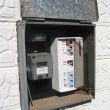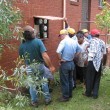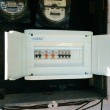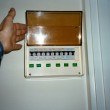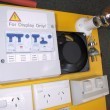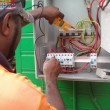A1.1 Safety switches
If there is a fault in an electrical appliance or electrical cables are damaged, a safety switch is designed to disconnect the power to prevent injury to residents. Electrical safety switches are also known as RCDs (residual current device) or ELCBs (earth leakage circuit breakers). Safety switches are required in addition to the circuit breakers that are fitted to prevent overloading of the electrical circuits. They are compulsory in all new houses and in renovations that involve electrical works. To minimise the risk of electrocution, electrical safety switches need to be fitted on every circuit in all houses.
Survey data show that most houses had electricity available (98%) but only 76% of houses had at least one working safety switch. This may relate to the age of houses surveyed, with the majority of houses over 10-years old (80%).
Design and Specification
Ensure
- A1.1.1.
electrical safety switches are retro-fitted to older houses
- A1.1.2.
electrical safety switches are fitted to new houses
- A1.1.3.
each circuit, including power, lights, air conditioning, refrigerator and, where appropriate or compulsory the hot water system and stove are protected by separate electrical safety switches
- A1.1.4.
people can easily reach the electrical safety switch to reset it or to isolate an electrical fault
- A1.1.5.
the meter box or switchboard is robust enough for regular access.
Consider
- locating the safety switches inside the house in a consumer switchboard
- checking the location and height of safety switches, so they can be reached by people with disabilities, but out of children’s reach
- specifying a switchboard with the capacity for future expansion; such as a modular enclosure with at least two extra blank circuits
- providing a number of circuits for lights and power in large houses
- separating the power circuits for the kitchen and wet areas, so that these areas can be isolated for safer cleaning.
- switchboard should be able to accommodate an expansion of 25%
Real world examples of Solutions
- A1.1.1.
Quality control
- the consumer switchboard is installed in the house at a height that is easy to reach by people with disabilities but not by young children

- COMPLETED DESIGN & SPECIFICATION
AT HANDOVER
- COMPLETED DESIGN & SPECIFICATION
- the consumer switchboard is installed in the house at a height that is easy to reach by people with disabilities but not by young children

- AT HANDOVER
FINAL COMPLETION
- AT HANDOVER
- all safety switches and circuit breakers can be turned on and off, and that the test buttons on the safety switches work

- AT HANDOVER
FINAL COMPLETION
TRADE TEST
- AT HANDOVER
- each circuit is labelled using a permanent marker, and that labels are easy to read and understand; for example, write ‘hot water system’ instead of ‘HWS’

- COMPLETED DESIGN & SPECIFICATION
AT HANDOVER
FINAL COMPLETION
TRADE TEST
- COMPLETED DESIGN & SPECIFICATION
- a qualified electrician has provided a ‘certificate of compliance’ for the electrical installation.

- AT HANDOVER
FINAL COMPLETION
TRADE TEST
- AT HANDOVER
- electrical safety switches and circuit breakers.

- AT HANDOVER
FINAL COMPLETION
TRADE TEST
- AT HANDOVER
- the consumer switchboard is installed in the house at a height that is easy to reach by people with disabilities but not by young children
Maintenance
As part of cyclical maintenance:
- show residents and community housing staff how to check that electrical safety switches are working properly and encourage regular checks; for example, check every three months as part of a community maintenance program

- Local Maintenance Team, Housing Management
- 3 Months
- trade test electrical safety switches and have a licensed electrician fix or replace faulty switches. Ensure electricians lodge a ‘notice of work’ when upgrading electrical safety switches.

- Electrician
- 24 Months
- show residents and community housing staff how to check that electrical safety switches are working properly and encourage regular checks; for example, check every three months as part of a community maintenance program
Standard And References
AS/NZS 3000:2018 - Electrical installations (known as the Australian/New Zealand Wiring Rules)
AS 1428.1:2021 - Design for access and mobility
AS 4299–1995 - Adaptable housing

